

R. Python and R for quantitative finance. Home of the JVM-based interpreter for the R language for statistical computing. How to update your Wordpress.com blog from R. I have become a complete knitr addict of late and have been using it in combination with RStudio’s R markdown support on a regular basis.
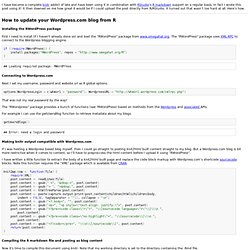
In fact I wrote this post using it! It then dawned on me how great it would be if I could upload the post directly from R/RStudio. It turned out that wasn’t too hard at all. Here’s how. How to update your Wordpress.com blog from R Installing the RWordPress package First I need to install (if I haven't already done so) and load the “RWordPress” package from www.omegahat.org. ## Loading required package: RWordPress Connecting to Wordpress.com Next I set my username, password and website url as R global options. options(WordpressLogin = c(wkmor1 = "password"), WordpressURL = " That was not my real password by the way!
The “RWordpress” package provides a bunch of functions (see ? For example I can use the getUsersBlog function to retrieve metadata about my blogs. getUsersBlogs() ## Error: need a login and password. Big Data Needs Scalable Analysis Tools Analytics-driven breakthroughs in various fields continue driving the desire for advanced analytics technologies.

Cost, performance and functionality -- common trade-offs in enterprising computing -- are becoming a challenge for IT professionals seeking to adopt analytics. Organizations' technological needs typically exceed existing tools' capabilities. Huge datasets, for example, continue increasing in size; single-core processors and legacy hardware cannot keep pace with the data explosion. IT leaders need scalable data-analysis software able to run on newer hardware, specifically software able to execute on multiple cores and/or in a distributed environment.
Impatient R. Translations français: Translated by Kate Bondareva.
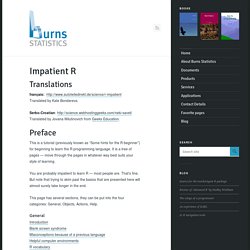
Serbo-Croatian: Translated by Jovana Milutinovich from Geeks Education. Preface This is a tutorial (previously known as “Some hints for the R beginner”) for beginning to learn the R programming language. It is a tree of pages — move through the pages in whatever way best suits your style of learning. You are probably impatient to learn R — most people are. This page has several sections, they can be put into the four categories: General, Objects, Actions, Help. General Introduction Blank screen syndrome Misconceptions because of a previous language Helpful computer environments R vocabulary Epilogue Objects Key objects Reading data into R Seeing objects Saving objects Magic functions, magic objects Some file types Packages Actions.
What You're Doing Is Rather Desperat. At any R Q&A site, you’ll frequently see an exchange like this one: Q: How can I use a loop to [...insert task here...] ?
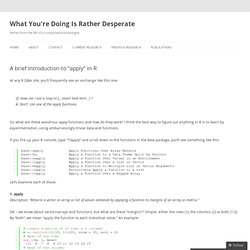
A: Don’t. Use one of the apply functions. So, what are these wondrous apply functions and how do they work? Rtips. Revival 2012! Paul E.
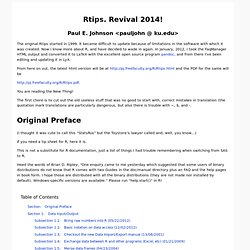
Johnson <pauljohn @ ku.edu> The original Rtips started in 1999. It became difficult to update because of limitations in the software with which it was created. Now I know more about R, and have decided to wade in again. In January, 2012, I took the FaqManager HTML output and converted it to LaTeX with the excellent open source program pandoc, and from there I’ve been editing and updating it in LyX. You are reading the New Thing! The first chore is to cut out the old useless stuff that was no good to start with, correct mistakes in translation (the quotation mark translations are particularly dangerous, but also there is trouble with ~, $, and -. (I thought it was cute to call this “StatsRus” but the Toystore’s lawyer called and, well, you know…) The R programming language for programmers coming from other programming la. IntroductionAssignment and underscoreVariable name gotchasVectorsSequencesTypesBoolean operatorsListsMatricesMissing values and NaNsCommentsFunctionsScopeMisc.Other resources Ukrainian translation Other languages: Powered by Translate Introduction I have written software professionally in perhaps a dozen programming languages, and the hardest language for me to learn has been R.
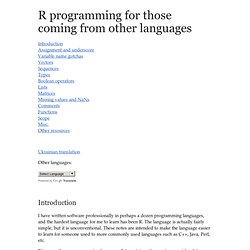
Twotorials by anthony damico. Quick-R: Home Page. R Resources for Beginners. The R podcast is available here: some of the episodes are specifically designed for beginners.
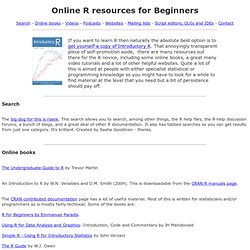
Impatient R Useful tutorial on R basics by Pat Burns. Includes lots of links and good advice on how the whole language works tryR Website with online tutorials in the R basics. Walks you through the fundamentals of the language. Example of why the R function apply() is hard to grok and how to use plyr i. OO field guide · Advanced R. This chapter is a field guide for recognising and working with R’s objects in the wild.

R has three object oriented systems (plus the base types), so it can be a bit intimidating. The goal of this guide is not to make you an expert in all four systems, but to help you identify which system you’re working with and to help you use it effectively. Central to any object-oriented system are the concepts of class and method. A class defines the behaviour of objects by describing their attributes and their relationship to other classes. The class is also used when selecting methods, functions that behave differently depending on the class of their input. R’s three OO systems differ in how classes and methods are defined: S3 implements a style of OO programming called generic-function OO. There’s also one other system that’s not quite OO, but it’s important to mention here: base types, the internal C-level types that underlie the other OO systems. Prerequisites Quiz Outline Base types Method dispatch. Welcome · Advanced R. R news & tutorials from the web.